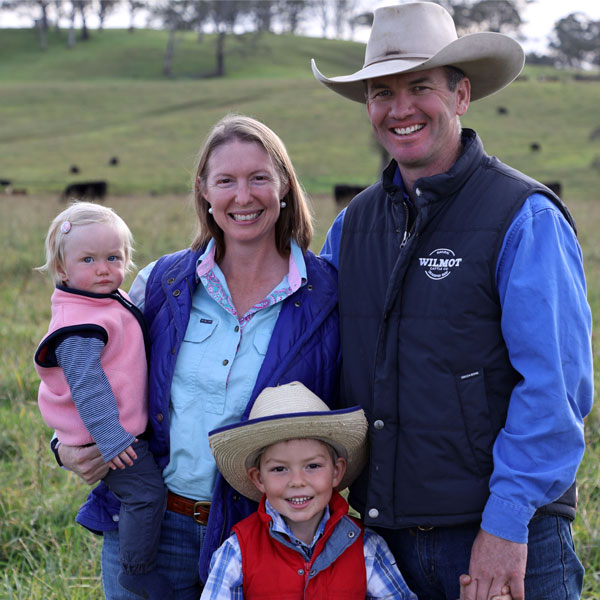Producing “real” protein with environmental benefits
Australia’s beef industry must take a “holistic” view to offsetting its carbon emissions with different sectors working together to bolster its environmental credentials.
That’s according to Wilmot Cattle Company General Manager Stuart Austin.
The grass-fed, three-farm, northern NSW 5,666 hectare beef operation was the first in the world to transact a major soil carbon credit sale.
Earlier this year, Wilmot Cattle Company sold $500,000 of carbon credits to Microsoft.
Key points
- Stuart Austin presented at the ALFA SmartBeef Bites Smart Sustainability webinar
- Entegra sponsored the webinar for the Australian grain fed beef sector
- Stuart shared his thoughts about how the beef industry could tackle it’s methane emissions
- Wilmot Cattle Company store carbon in the soil
Stuart Austin, GM Wilmot Cattle Company, presented – Smart Sustainability
The highly publicised deal was in exchange for the carbon added to the soil at Wilmot Cattle Company from 2017-2020.
These credits will be used by the tech giant to offset some of its carbon emissions.
Stuart shared his thoughts about how the beef industry could tackle its’ methane emissions, while explaining how Wilmot Cattle Company stored carbon in the soil, as part of the Entegra sponsored Australian Lot Feeders’ Association (ALFA) SmartBeef Bites Smart Sustainability webinar recently.
“Significantly carbon positive” Stuart said Wilmot Cattle Company ticked environmental and productivity boxes.
“We demonstrated that we are continuing to produce real protein – and I’m talking about beef here – and improve ecological health and that’s a narrative we are all trying to counter in the beef industry most days of the week,” he said.
“We are still producing the same amount, if not more beef, than we were producing in the past and as a result of how we are producing that beef, we have built our soil carbon levels or increased our soil carbon levels.
That carbon is still in our soil, on farm, and still benefitting our production system, that is the opportunity that really presents itself here for industry.”
Grazing management, reducing farm inputs and deep-rooted perennial pastures were just some of the ways Wilmot Cattle Company stores carbon in its soil.
While data ensures it’s managed and measured accurately.
Rotationally grazing a small number of large cattle groups in “very small” paddocks – moved frequently – helps ensure longer paddock rest periods.
“Every time we graze a paddock, we are effectively stimulating that process of photosynthesis, letting that grass get back to… (it’s) top vegetive stage until it goes into reproduction, grazing it again and away that cycle goes again,” Stuart said.
“Graze and rest.”
Soil carbon has been built a “long way” down the soil profile – “two to three feet” (61-91cm) – thanks to the deep rooted perennial pastures and the temperate wet climate.
Carbon, phosphorus, and nitrogen levels have continued to increase despite a reduction of synthetic inputs during the past 10 years, Stuart told the webinar.
The farm’s received a “significant” lime program early in the practice change and for the past three-to-five years he said chook manure and a few trace minerals were applied.
“Reducing synthetic inputs reduced our cost structure and reduced a significant amount of risk from the business,” Stuart said. “What we talk about is using animals, notinputs to build soil carbon.”
Stuart encouraged the entire beef industry to work together, talking a whole of supply chain view towards building soil carbon to offset methane emissions.
He suggested feedlots could use associated farmland to store carbon dioxide emissions, implementing more regenerative agriculture practices such as cover crops, silage crops, reducing bare land and encourage feed suppliers to do the same.
Renewable energy is a “no brainer”, while novel feed methane inhibitors such as seaweed and 3-NOP are “showing promise,” according to Stuart.
Stuart was one of three speakers at the ALFA SmartBeef Bits Sustainability webinar sponsored by Entegra.
Sea Forest was established in 2018, expanding on Meat and Livestock Australia funded CSIRO and James Cook University funded research into feeding livestock to seaweed to reduce emissions.
This research identified the red seaweed Asparagopis could “virtually eliminate emissions” by feeding it at a rate of 0.2 per cent of a cow’s diet or 30grams/head a day.
“Scientists also found seaweed supplements resulted in productivity, basically the bioactive compounds inside the seaweed disrupt the enzymatic pathway which would normally lead to the production of methane and converting that which would have been dispelled by the animal as a gassy waste product…into energy the animal uses to grow faster,” Mr Elsom said.
“The existing science points to an average of about 20 per cent increase in productivity, (so we are) talking about a positive environmental impact and also an increase in profitability for farmers.”
This work has been replicated throughout the world and the first trials of Sea Forest product have been conducted by a Tasmanian wool grower and dairy giant Fonterra.
Mr Elsom said he’s speaking with leading feedlot and cattle companies to start trials in these sectors.
The price of the product would be about $1/head a day.
Mr Elsom told the webinar the global seaweed industry was worth $11 billion, but in Australia it was only $2 million as farming was restricted to native or endemic species, most of which occurred in the northern hemisphere.
Other parts of the world are restricted from farming Asparagopis.
Mr Elsom was one of three speakers at the webinar sponsored by Entegra.

